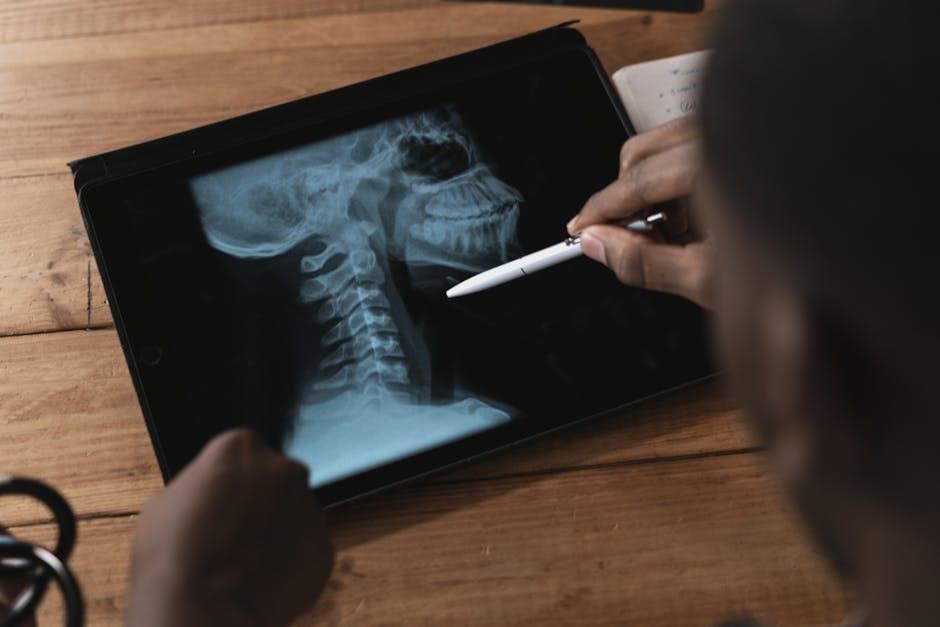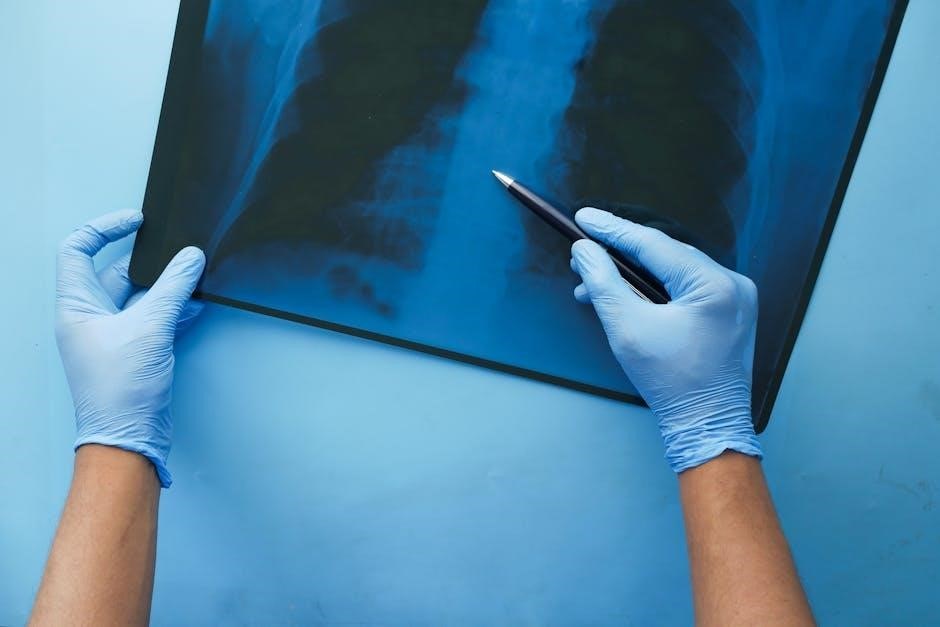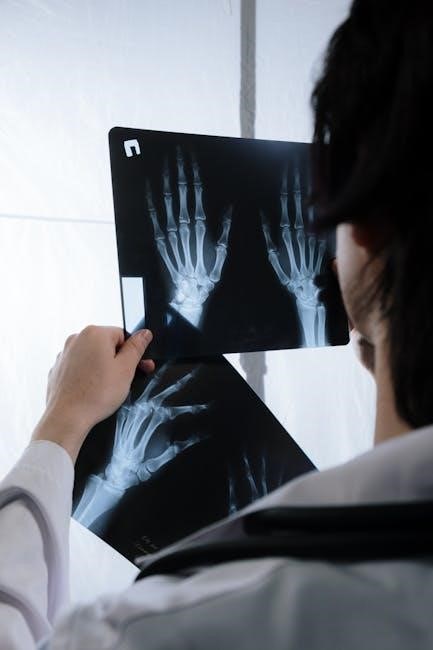Distal radius fractures are common injuries, especially in older adults, often caused by falls. Exercises play a crucial role in restoring wrist movement, strength, and function. Early rehabilitation helps prevent stiffness and promotes healing, with a focus on range of motion, strengthening, and mobility. A structured exercise plan, starting immediately after injury and progressing over weeks, is essential for optimal recovery and returning to daily activities.
1.1 Understanding the Importance of Rehabilitation
Rehabilitation is crucial for restoring wrist function after a distal radius fracture. It helps regain range of motion, strength, and mobility, reducing stiffness and promoting healing. Supervised therapy ensures proper alignment and prevents complications like arthritis or nerve damage. Consistent exercises improve grip strength and flexibility, enabling patients to return to daily activities and sports. Early intervention and adherence to a structured program significantly enhance recovery outcomes and long-term wrist health.
1.2 Overview of the Healing Process
The healing process after a distal radius fracture typically spans several weeks, beginning with immobilization. In the first two weeks, the fracture stabilizes, followed by gradual wrist movement. By six weeks, active exercises commence to restore flexibility and strength. Full recovery may take several months, with exercises tailored to each phase. Proper adherence ensures optimal healing and functionality.
Types of Exercises for Distal Radius Fracture
Exercises for distal radius fractures include range of motion, strengthening, flexibility, and grip exercises, tailored to promote healing, restore mobility, and rebuild wrist function effectively.
2.1 Range of Motion Exercises
Range of motion exercises are essential for restoring wrist mobility after a distal radius fracture. These exercises focus on gentle movements like wrist flexion, extension, radial deviation, and forearm rotation. Typically performed while the wrist is still in a cast, they help maintain joint flexibility and prevent stiffness. Post-cast removal, active exercises are introduced to enhance movement. Consistency is key, with exercises often done multiple times daily. These movements are foundational for regaining functional use of the wrist and hand, ensuring proper healing and recovery.
2.2 Strengthening Exercises
Strengthening exercises are vital for restoring lost muscle strength and function after a distal radius fracture. These exercises often begin 6-8 weeks post-injury, focusing on wrist flexion, extension, and grip strength. Tools like resistance bands and light weights are commonly used to gradually increase intensity. Strengthening not only improves wrist mobility but also enhances overall arm function, enabling patients to perform daily activities and return to pre-injury levels of independence and activity. Consistency and progression are key to achieving optimal results.
2.3 Flexibility and Mobility Exercises
Flexibility and mobility exercises are essential to restore wrist range of motion after a distal radius fracture. Gentle stretching techniques target the wrist and forearm, improving supination and pronation. Early immobilization can lead to stiffness, making these exercises critical. Patients are often advised to perform exercises like wrist flexion, extension, and radial-ulnar deviation daily. Heat therapy before exercises can enhance flexibility and reduce discomfort. Consistent practice helps regain functional movement, ensuring the wrist can perform everyday tasks without restriction or pain, promoting a full recovery.
2.4 Grip Strengthening Exercises
Grip strengthening exercises are vital for restoring hand function after a distal radius fracture. Activities like squeezing a rubber ball or using resistance bands help rebuild grip strength. Patients can also use specialized tools, such as stress balls or hand grippers, to progressively increase intensity. Gentle exercises, like thumb-to-finger touches, improve dexterity and pinch strength. Regular practice enhances ability to perform daily tasks, such as holding objects or twisting lids, aiding in full recovery and independence.
When to Start Exercises After a Fracture
Exercises should begin immediately post-injury with gentle finger and elbow movements while in a cast. Active wrist exercises start after 6 weeks, once healing is confirmed.
3.1 Immediate Post-Injury Phase (0-2 Weeks)
During the first two weeks post-injury, patients typically remain in a splint or cast to immobilize the fracture. Gentle exercises for fingers, thumb, and elbow can begin immediately to prevent stiffness. These exercises should be done carefully to avoid disrupting the healing process. A structured approach ensures proper alignment and minimizes complications; Patients are advised to follow specific protocols provided by healthcare professionals during this critical phase to promote optimal recovery and prepare for more active rehabilitation in later stages.
3.2 Active Range of Motion Phase (After 6 Weeks)
After 6 weeks, patients typically transition to active range of motion exercises to restore wrist mobility. Gentle exercises like wrist flexion, extension, and forearm rotation are introduced. These movements help improve joint flexibility and reduce stiffness. Patients may use resistance bands for light strengthening. It’s crucial to avoid overexertion and follow guidelines to prevent complications. Regular monitoring by a healthcare provider ensures proper healing and progress. This phase focuses on gradually increasing wrist movement and strength, preparing for more advanced exercises in later stages of recovery.

Role of Physical Therapy in Recovery
Physical therapy is crucial after a distal radius fracture, helping restore wrist mobility, strength, and function. It ensures proper healing, prevents stiffness, and tailors exercises to individual needs for full recovery.
4.1 Benefits of Supervised Rehabilitation
Supervised rehabilitation provides professional guidance, ensuring exercises are performed correctly and safely. It offers customized treatment plans tailored to individual needs, promoting faster recovery. Regular monitoring by therapists allows for timely adjustments, optimizing progress. Supervised sessions also reduce the risk of improper technique, preventing further injury. Additionally, the structured environment motivates patients, fostering adherence to their exercise routines. This personalized approach enhances overall outcomes, helping patients regain strength, mobility, and function effectively.
Exercises to Avoid During Recovery
Weight-bearing exercises, heavy lifting, and high-impact activities should be avoided to prevent disrupting the healing process. Avoid bending, twisting, or repetitive stress on the wrist.
5.1 Activities That May Hinder Healing
Certain activities can impede recovery and should be avoided. Weight-bearing exercises, heavy lifting, and repetitive wrist movements may disrupt bone alignment and delay healing. Activities involving twisting or bending the wrist should be avoided until fully healed. Additionally, high-impact sports and exercises that cause vibration or stress on the wrist can interfere with the fracture repair process. Patients should avoid gripping heavy objects or performing repetitive tasks that strain the wrist. Consulting a healthcare provider before resuming such activities is crucial to ensure proper healing and prevent complications.

Equipment for Effective Rehabilitation
Resistance bands and TENS machines are essential tools for rehabilitation. Resistance bands help strengthen muscles, while TENS machines provide pain relief, enhancing the recovery process effectively.
6.1 Resistance Bands
Resistance bands are versatile tools for strengthening exercises during distal radius fracture recovery. They provide gentle yet effective resistance to improve wrist, forearm, and grip strength. Lightweight and portable, bands can be used for exercises like wrist flexion, extension, and rotation. They help restore muscle tone, prevent atrophy, and enhance joint mobility. Incorporating resistance bands into daily routines aids in regaining functional abilities and accelerates the healing process, making them a valuable addition to any rehabilitation program for distal radius fractures.
6.2 TENS Machine for Pain Relief
A TENS (Transcutaneous Electrical Nerve Stimulation) machine is a non-invasive, portable device that sends mild electrical impulses to nerves, reducing pain and discomfort. Often used during distal radius fracture recovery, it helps alleviate swelling and stiffness, making exercises more manageable. The machine is easy to use at home and provides drug-free pain relief. By easing discomfort, it enables patients to perform rehabilitation exercises more effectively, promoting faster healing and improved mobility. Always consult a healthcare provider before using a TENS machine for proper guidance.

Mental and Emotional Aspects of Recovery
Mental and emotional well-being significantly impact recovery from a distal radius fracture. Staying motivated and engaged in exercises ensures better outcomes and faster healing. Emotional support and trust-building with therapists are crucial for a smooth recovery journey.
7.1 Importance of Patient Motivation
Patient motivation is a cornerstone of successful recovery from a distal radius fracture. Staying committed to prescribed exercises ensures consistent progress and prevents setbacks. Positive mindset and clear communication with healthcare providers foster resilience. Setting achievable goals enhances engagement and adherence to rehabilitation routines. Motivation also helps manage pain and frustration, crucial for regaining wrist function and strength. Encouraging support systems and celebrating small milestones can significantly boost a patient’s drive throughout the healing process.
Nutrition for Bone Healing
Proper nutrition supports bone healing in distal radius fractures. Focus on calcium-rich foods like dairy and leafy greens, vitamin D, and protein. Avoid alcohol and smoking to enhance recovery.
8.1 Diet Recommendations
A balanced diet rich in calcium, vitamin D, and protein is crucial for bone healing after a distal radius fracture. Include calcium-rich foods like leafy greens, fortified dairy, and fish. Vitamin D, found in fatty fish and fortified products, enhances calcium absorption. Protein from lean meats, eggs, and legumes supports tissue repair. Stay hydrated and avoid smoking and alcohol, as they impede healing. A nutrient-dense diet promotes stronger bone regeneration and faster recovery, ensuring optimal outcomes during rehabilitation.

Avoiding Complications
Monitor for stiffness, persistent pain, or improper healing. Early detection of complications ensures timely intervention, preventing long-term issues like limited wrist mobility or chronic discomfort.
9.1 Early Signs of Complications
Early signs of complications may include increased pain, swelling, or limited mobility beyond expected levels. Numbness, tingling, or discoloration in the hand or fingers can indicate nerve or circulation issues. Difficulty moving the wrist or fingers, even after starting exercises, may signal improper healing. Monitoring for these signs is crucial, as addressing them promptly can prevent long-term damage or the need for additional medical intervention.
Long-Term Recovery and Prognosis
Most patients achieve full recovery, regaining wrist function and returning to normal activities. Some may experience minor limitations in motion, but overall prognosis remains positive with proper rehabilitation.
10.1 Expectations After Full Recovery
After full recovery, most patients regain near-normal wrist function, allowing them to resume daily activities and sports. Some may experience slight limitations in wrist motion or grip strength, but these are usually manageable. With proper rehabilitation, the prognosis is excellent, and many patients return to their pre-injury lifestyle without significant long-term issues. Continued adherence to exercises ensures lasting strength and mobility, minimizing the risk of future complications.

Technology in Rehabilitation
Technological advancements, such as robotic systems and virtual reality, enhance engagement and precision in rehabilitation, offering personalized exercise plans and real-time feedback to optimize recovery outcomes.
11.1 Use of Robotics
Robotics in distal radius fracture rehabilitation offers precise, personalized exercise plans and real-time feedback, enhancing engagement and recovery outcomes. These systems provide controlled movements, reducing strain and improving joint mobility. By integrating interactive elements, robotics makes therapy more engaging, fostering adherence to exercise regimens. This technology also allows for remote monitoring, enabling clinicians to track progress and adjust plans as needed. Robotics not only accelerates recovery but also ensures a more motivating and effective rehabilitation experience for patients with wrist fractures.

Creating a Daily Exercise Routine
Organize your exercises into a structured daily plan, starting with gentle movements and gradually increasing intensity. This approach ensures consistent progress and prevents overexertion, promoting steady healing and recovery.
12.1 Structuring Your Workout Plan
A well-structured workout plan is essential for effective recovery from a distal radius fracture. Begin with gentle exercises during the initial healing phase (0-2 weeks), focusing on finger mobility to prevent stiffness. Progress to wrist range of motion exercises (weeks 2-6), incorporating wrist flexion, extension, and rotation. After 6 weeks, introduce strengthening exercises using resistance bands and light weights to improve grip and forearm strength. Include rest days to avoid overexertion and ensure steady, balanced progress. Consistency and gradual intensity are key to achieving full recovery and functionality.

Resources for Further Information
Recommended PDF guides and hand therapy protocols provide detailed exercise routines, recovery tips, and rehabilitation timelines for distal radius fractures, ensuring comprehensive and informed recovery support.
13.1 Recommended PDF Guides
Several comprehensive PDF guides are available, offering detailed exercise routines, recovery timelines, and rehabilitation protocols for distal radius fractures. These resources, such as the Distal Radius Fracture Non-Operative Rehabilitation Protocol and Post-Operative Hand Therapy Guidelines, provide step-by-step instructions for patients and clinicians. They include illustrations of exercises like wrist flexion, extension, and forearm rotation, as well as tips for managing pain and improving grip strength. These guides are invaluable for ensuring a structured and effective recovery process, catering to both surgical and non-surgical cases.



